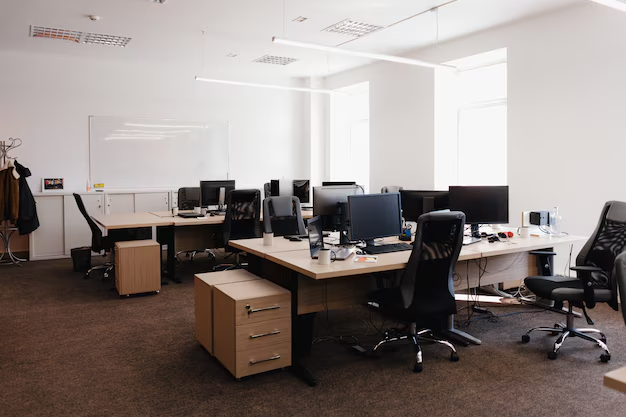
The design of call center offices significantly impacts productivity, employee engagement, and job satisfaction. Unlike traditional office spaces, call centers have unique requirements, including managing high volumes of phone conversations, facilitating quick collaboration, and addressing customer service needs.
By focusing on these specific demands, optimizing call center office design can greatly enhance overall performance and foster a more inviting workplace environment. In this blog, we will explore essential strategies to maximize productivity through thoughtful call center office design.
The Importance of Call Center Office Design

Before exploring specific design strategies, it’s essential to recognize the significance of Call Center Office Design. In today’s fast-paced and high-pressure environment, the layout and atmosphere can either hinder or enhance performance. A well-thought-out call center interior design can lead to improvements in several areas:
Employee Productivity:
The design, layout, and acoustics of a call center help agents concentrate on their tasks, enabling them to manage a higher volume of calls effectively.
Morale and Well-being:
A comfortable and welcoming environment can reduce stress and fatigue, leading to improved overall performance.
Teamwork and Collaboration:
Open spaces or collaborative areas facilitate communication among team members and management, particularly regarding complex or escalated calls.
Customer Experience:
When employees work in a supportive and effective environment, the quality of customer service improves, directly contributing to the company’s success.
Essential Design Elements for Call Center Performance

Ergonomically Designed Workstations
Investing in well-designed workstations is essential for call centers, where employees spend long hours at their desks and often handle numerous calls in a row. An ergonomically designed workspace enhances comfort and focus throughout shifts.
Adjustable chairs with lumbar support can alleviate back pain, a common issue in call center environments. Similarly, height-adjustable desks allow employees to easily switch between sitting and standing, helping to prevent fatigue and promote good posture.
Additionally, dual-monitor setups enable employees to access information more quickly, which reduces time spent on tasks and allows for more efficient call handling.
Implementing these ergonomic solutions can decrease absenteeism due to physical strain and enhance employee comfort, ultimately leading to increased productivity.
Innovative Office Renovation Ideas
Call center design layouts should be designed to foster uninterrupted workflow and balance individual focus with team collaboration. To maximize production and employee satisfaction, several strategies can be implemented:
- Clustered seating arrangement: Arranging employees in small groups or “pods” of 4-6 people can promote teamwork and access to managers, especially in large call centers with frequent escalations.
- Clearly demarcated walkways: Walkways between workstations should be clearly defined to ensure smooth movement without interruptions, minimizing distractions for employees on calls.
- Dedicated collaboration zones: Designating specific areas for team meetings or quick huddles away from the main floor allows for discussions without disrupting employees currently on customer calls.
Acoustic Solutions for Noise Management
Call centers often struggle with excessive noise due to constant conversations. This can hinder employee focus and lead to poor call quality. To address this, several strategies can be implemented:
- Acoustic treatments: Installing sound-absorbing panels on walls and ceilings can reduce noise levels.
- Carpeting: Using carpets on floors can help absorb sound and minimize echoes.
- White noise machines: These can mask distracting sounds and improve concentration.
- Partitioning: High desk partitions or cubicles can create more private workspaces and reduce noise distractions.
By minimizing noise, call centers can enhance employee productivity and ensure clear communication with customers.
The Impact of Lighting on Productivity
Good lighting is essential in call centers to enhance focus, reduce eye strain, and improve employee mood. Here’s how to optimize lighting:
- Maximize Natural Light: Whenever possible, allow ample natural light into the workspace. This can help alleviate depression and reduce headaches, common issues in call center environments due to extended screen exposure.
- Energy-Efficient LED Lighting: In areas without windows, use energy-efficient LED lighting that mimics daylight. LEDs minimize glare on computer screens, further reducing eye strain.
- Personal Task Lighting: Provide employees with personal desk lamps to allow them to control the lighting in their immediate work area.
Effective lighting design not only promotes employee comfort but also creates a more pleasant atmosphere, leading to increased productivity and performance.
Amenities for Breakout Spaces and Wellness
Call center employees often experience high stress levels due to the volume and nature of their customer interactions. Providing dedicated relaxation spaces can significantly improve employee well-being and long-term productivity.
- Lounge areas should offer comfortable seating, soothing colors, and natural elements to create a calming atmosphere where employees can unwind and recharge.
- Wellness rooms, when available, provide a dedicated space for employees to practice mindfulness or meditation during short breaks.
- Quiet spaces allow employees to isolate themselves for focused work or to simply escape the constant customer interaction.
These spaces contribute to employee mental health and well-being, enabling them to return to work refreshed and ready to perform at their best.
Conclusion
Creating a call center environment that fosters both productivity and employee well-being requires more than just aesthetics. By prioritizing ergonomic workstations, efficient layouts, acoustic solutions, proper lighting, breakout spaces, and seamless technology integration, businesses can create a space that supports the unique demands of call center employees. This approach not only enhances employee satisfaction but also drives overall organizational success.
